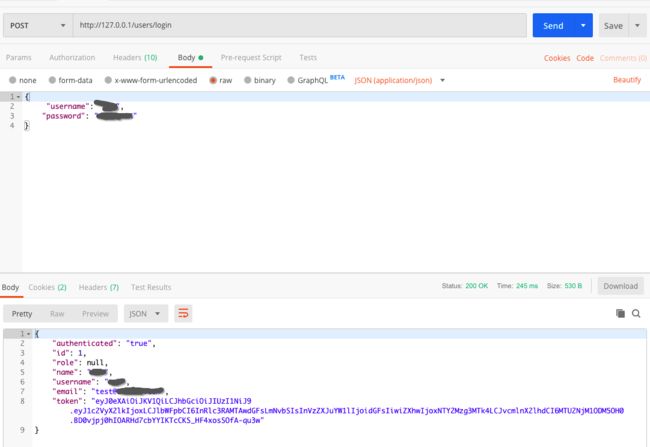Django REST framework JWT 和登录功能实现
前后分离token的方式做登录身份校验,jwt校验方式更加简单便捷化,无需通过redis缓存,而是直接根据token取出保存的用户信息,以及对token可用性校验,单点登录更为简单。
配置环境:
python 3.7
Django==2.1.11
djangorestframework-jwt==1.10.0
一、安装
pip install djangorestframework-jwt
二、配置
1.打开项目中settings配置
import datetime
# drf框架的配置信息
REST_FRAMEWORK = {
# 设置所有接口都需要被验证
'DEFAULT_PERMISSION_CLASSES': (
#’rest_framework.permissions.IsAuthenticatedOrReadOnly’,
),
# 用户登陆认证方式
'DEFAULT_AUTHENTICATION_CLASSES': (
‘rest_framework_jwt.authentication.JSONWebTokenAuthentication’,
#’rest_framework.authentication.SessionAuthentication’,
#’rest_framework.authentication.BasicAuthentication’,
),
}
# jwt载荷中的有效期设置
JWT_AUTH = {
#token 有效期
'JWT_EXPIRATION_DELTA': datetime.timedelta(hours=8),
'JWT_ALLOW_REFRESH': True,
#续期有效期(该设置可在24小时内带未失效的token 进行续期)
'JWT_REFRESH_EXPIRATION_DELTA': datetime.timedelta(hours=24),
# 自定义返回格式,需要手工创建
'JWT_RESPONSE_PAYLOAD_HANDLER': ‘Users.utils.jwt_response_payload_handler’,
}
2.创建自定义返回数据格式
# 创建用户应用
python manage.py startapp Users
在Users应用目录下新建utils.py 并配置文件
“””
自定义jwt认证成功返回数据
:token 返回的jwt
:user 当前登录的用户信息[对象]
:request 当前本次客户端提交过来的数据
:role 角色
“””
def jwt_response_payload_handler(token, user=None, request=None, role=None):
if user.first_name:
name = user.first_name
else:
name = user.username
return {
"authenticated": ‘true’,
'id': user.id,
"role": role,
'name': name,
'username': user.username,
'email': user.email,
'token': token,
}
三、使用
- 申请token
1.打开项目中urls.py 配置路由
from django.contrib import admin
from django.urls import path, include
urlpatterns = [
path('admin/', admin.site.urls),
path('users/', include('Users.urls’)),
]
2.在Users应用目录下创建并打开urls.py
# jwt内部实现的登陆视图
from rest_framework_jwt.views import obtain_jwt_token, refresh_jwt_token
from django.urls import path
urlpatterns = [
path(r"login", obtain_jwt_token),
]
3.打开postman
- token 续期
在Users应用目录下打开urls.py
# jwt内部实现的登陆视图
from rest_framework_jwt.views import obtain_jwt_token, refresh_jwt_token
from django.urls import path
urlpatterns = [
path(r"login", obtain_jwt_token),
path(r"refresh", refresh_jwt_token),
]
四、验证
验证的时候,我们使用的是rest_framework 框架,该框架使用将在其他文档详细叙述。
permission是权限验证 IsAuthenticated必须登录用户 IsOwnerOrReadOnly必须是当前登录的用户
from rest_framework.permissions import IsAuthenticated,IsAuthenticatedOrReadOnly
# 分页配置
class LargeResultsSetPagination(PageNumberPagination):
page_size = 10
page_size_query_param = 'page_size'
max_page_size = 10000
# 域名列表
class DomainManageList(viewsets.ReadOnlyModelViewSet):
# authentication是用户认证
authentication_classes = (JSONWebTokenAuthentication,)
# permission是权限验证 IsAuthenticated必须登录用户 IsOwnerOrReadOnly必须是当前登录的用户
# permission_classes = (IsAuthenticated, IsOwnerOrReadOnly)
#判断是否登陆
permission_classes = (IsAuthenticated, )
#查询所有信息
queryset = Domain_Manage.objects.all()
#序列化
serializer_class = DomainManageListSerializers
pagination_class = LargeResultsSetPagination

